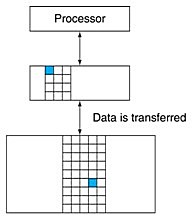There are four primary technologies used in building memory hierarchy: (i) SRAM (static random access memory), (ii) DRAM (dynamic RAM), (iii) flash memory, and (iv) magnetic disk. The table shows the access time and price per bit among these memories using typical values for 2020:
| Memory technology | Typical access time | $ per GiB in 2020 |
|---|---|---|
| SRAM semiconductor memory | 0.5–2.5 ns | $500–$1,000 |
| DRAM semiconductor memory | 50–70 ns | $3–$6 |
| Flash semiconductor memory | 5,000–50,000 ns | $0.06–$0.12 |
| Magnetic disk | 5,000,000–20,000,000 ns | $0.01–$0.02 |
The memory hierarchy is based on the principle of locality of references, which states that programs access a relatively small portion of their address space at any instant of time. There are two types of locality:
- Temporal locality (locality in time): If an item is referenced, it will tend to be referenced again soon. For example, same loop instructions are fetched each iteration.
- Spatial locality (locality in space): If an item is referenced, items whose addresses are close by will tend to be referenced soon. For example, sequentially execute instructions.
| If the data requested by the processor appears in the upper level, this is called a hit. Otherwise, the request is called a miss. The lower level in the hierarchy is then accessed to retrieve the block containing the requested data. The hit rate or hit ratio, the fraction of memory accesses found in the upper level, is usually high because of the principle of locality of references. |

|